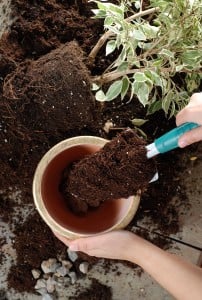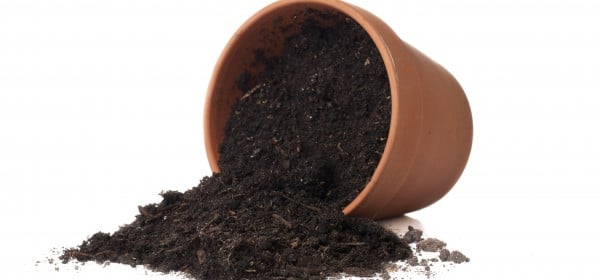Without soil your plants won’t survive. Just like sun and water, your plants also need a nice meaty soil to sink their roots into. When planting potted plants you are solely responsible for creating just the right environment. After all, the roots of a plant can’t reach outside of the planter, meaning they have to find everything they need right there in that pot. So how do you make sure the soil you select is good enough to support the life of your plants?
Here we break down what you need to know about different types of soils, and which planter soil is best for your container garden. Plus, how you can test soil to see if it matches up to its listed ingredients.
Different Types Of Planter Soil
Soil is largely made up of organic matter and mineral particles. The three main types of soil minerals include clay, silt, and sand. How much of each mineral ingredient a soil possesses will determine the texture of the soil, as well as how it absorbs water, feeds plants, retains moisture, and so forth.
Clay soil has the least amount of soil particles, as well as the least amount of water and air between each particle. This means clay soil drains well, dries out quickly, and is slow to warm up. Although, when properly watered it can retain a good amount of moisture. Think about clay in general, it’s moist qualities can last for a good amount of time.
Sand soil contains the largest individual particles, and also the largest amount of water and air between each particle. A soil that contains 50% sand will warm up fast and dry out easy, but is very useful when efficient drainage is necessary.
Silt soil is halfway between clay soil and sand soil in terms of thickness and space between particles. Silt soil is considered very similar to clay soil, although it does have larger particles.
Typically, you want a soil that includes a nice mix of all of these minerals, as each type has a different set of characteristics. A popular type of soil is called loam soil, which is made up of 40% sand, 40% clay, and 20% silt.
Organic Vs. Non Organic Potting Soils

Potting soils can be tricky, as they are mixed together by a company that might be trying to save money over all else. The scary thing is potting soils can be full of nothing but empty man-made fillers. If a potting soil bag is incredibly heavy, this could mean it’s overly moist, or it could mean there is a lot of sand in it—neither is ideal at all.
For the sake of simplicity, there are two types of potting soils, organic soils and non-organic soils. Organic soils are natural and have microscopic organisms inside of them that make the soil more nutritious and long lasting.
Non-organic potting soils are made with manure, peat, hummus, and other like-ingredients. The nutrients in non-organic potting soils are made by humans and not naturally occurring. You can think of non-organic soils like eating McDonalds, it will sustain life for a while, but at some point you are going to need some real nutrients. Non-organic soil must be removed and replaced every season. After this short amount of time there are no longer adequate nutrients left in the soil for the plant to absorb.
How To Know Exactly What is in Your Soil: Soil Tests
While your soil bag might brag that it’s the best for your potted plants, there’s only one-way to know for sure: test it out yourself. While there are a number of different soil tests out there, here are 2 of our favorites, the ribbon test and the jar test.
How To Use The Ribbon Test On Your Soil
Take a nice moistened ball of soil and roll it into a ball between your fingers. Then pinch it between your forefinger and thumb, to create a ribbon effect. If the soil stands up straight when held as a ribbon in the air, it has very little clay. Exactly how much clay is present in your soil depends on how thin your soil ribbon can be rolled without breaking.
2- 3 ½ inches= 40% clay
½- 3 inches long= 50% clay
How To Use The Jar Test On Your Soil
Take one inch of soil and pour it into a tall clear jar. Fill up 2/3 of the jar with water, and add 1 teaspoon of table salt. Shake until the sand, water, and salt mix together, and then let your concoction settle.
After one minute, the sand will settle to the bottom of the jar, allowing you to measure the layer of sand.
In 4-5 hours the silt will sink to the bottom, forming a layer atop the sand that you can measure.
In a few days, the clay will finally have settled down into a third layer, which also can be measured.
This allows you to see a visual breakdown of the soil and its contents.
http://strongertogether.coop/fresh-from-the-source/growing-your-own-food/all-about-soil/
The Best Type of Soil For Your Plants
Think of your plants when you are determining the best type of soil for them, do they prefer moist or dry conditions? Does it rain a lot where you live, or does it rain very little? Once you have selected your potting soil, it’s important to water, feed, and care for your plants based on their needs, and the tendencies of the soil.
No matter what type of soil you have, you can make it drain more efficiently by adding a layer of foliage and other organic matter. To do so, add about 4-6 inches of grass, plants, manure, or whatever natural additives you have handy, to the top of the soil in the winter. In the spring, add another 1-2 inch layer.
While non-organic soils might cost less up front, they have to be supplemented and changed out regularly in order to give your plants what they need. Plants derive all of their energy and nutrients from the soil provided, keep your plants healthy by selecting the right type of soil and keeping up with necessary soil maintenance.
http://www.wikihow.com/Choose-Plant-Soil
Need great looking planters to go with your high-quality soil and beautiful blooming flowers? At TerraCast Planters we carry a wide selection of planters for every project—big and small!

